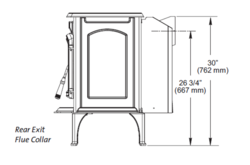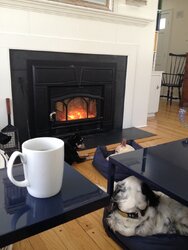Other than continuing to hijack other threads thought it would be best to post separately.
Have a Jotul Rockland 550 insert approximate 2.2 cubic foot firebox (24” w x 11.5” D x 14” H) in a center chimney with block off plate. It is rated at around 1,800 square feet which it does quite admirably. However I am in an approximate 2,500 square foot house and when the temperature drops below 30 the stove really struggles to keep up. Normally I kick the furnace on in the morning and again once or twice further throughout the day to keep the stove room temperature in the high 60’s very low 70’s. The rest of the house varies between 5-10 degrees cooler.
My question is for those that have gone from an insert with a small to mid-size firebox to a full 3 cubic foot (or over) firebox/free standing woodstove, have you seen appreciable gains in heat?
I know each house/setup is different based on square footage, insulation, number of windows and obviously wood quality. But would like to hear about others experiences, the stoves they went to and in the end was it worth the change (and not stickily from a financial perspective)?
Have a Jotul Rockland 550 insert approximate 2.2 cubic foot firebox (24” w x 11.5” D x 14” H) in a center chimney with block off plate. It is rated at around 1,800 square feet which it does quite admirably. However I am in an approximate 2,500 square foot house and when the temperature drops below 30 the stove really struggles to keep up. Normally I kick the furnace on in the morning and again once or twice further throughout the day to keep the stove room temperature in the high 60’s very low 70’s. The rest of the house varies between 5-10 degrees cooler.
My question is for those that have gone from an insert with a small to mid-size firebox to a full 3 cubic foot (or over) firebox/free standing woodstove, have you seen appreciable gains in heat?
I know each house/setup is different based on square footage, insulation, number of windows and obviously wood quality. But would like to hear about others experiences, the stoves they went to and in the end was it worth the change (and not stickily from a financial perspective)?
Last edited by a moderator:



